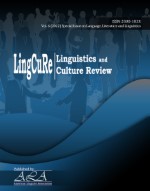Pronoun beta and ose in Moluccas Malay
Keywords:
anthropolinguistics, different vocabulary, Moluccas Malay, pronoun beta oseAbstract
Moluccas Malay is generally spoken in Moluccas and North Moluccas Provinces. However, every place in those provinces has its own different vocabulary usage of the language like in Tanimbar Archipelago Regency. One of the differences can be seen by the usage of pronouns, especially the first person singular beta and the second person singular ose. In Tanimbar, beta is usually changed to saya and sa, while ose is usually changed to kau, engko, itrana, and itwata. In another place like Ambon, ose is sometimes changed to ale. In addition to regional differences, different situations also affect changes in the use of the two pronouns. This is analyzed by using the acronym SPEAKING in anthropological linguistics to be able to find out the speech situation such as place, time, speaker and addressee, purpose, act sequence of the speech, and others. Research data were collected using observation, interview, and documentation techniques which were then analyzed using data reduction, data display, and data conclusion. The results showed that the rules for using the pronouns beta and ose depend on different situations such as in the family when meeting new people, differences in age, gender, social groups.
Downloads
References
Bawa, I. W., & Cika, I. W. (2004). Bahasa dalam Perspektif Kebudayaan. Universitas Udayana.
Berger, P. L. (1990). Tafsir sosial atas kenyataan: Risalah tentang sosiologi pengetahuan.
Chaer, A. (2012). Lingui?ik Umum. Jakarta: PT Rineka Cipta.
Collins, J. T. (1980). Ambonese Malay and creolization theory (No. 5). Dewan Bahasa dan Pustaka, Kementerian Pelajaran, Malaysia.
Coxhead, A., & Byrd, P. (2007). Preparing writing teachers to teach the vocabulary and grammar of academic prose. Journal of second language writing, 16(3), 129-147. https://doi.org/10.1016/j.jslw.2007.07.002
Duranti, A. (1997). Universal and culture?specific properties of greetings. Journal of linguistic Anthropology, 7(1), 63-97.
Friederici, A. D. (1985). Levels of processing and vocabulary types: Evidence from on-line comprehension in normals and agrammatics. Cognition, 19(2), 133-166. https://doi.org/10.1016/0010-0277(85)90016-2
Hobbs, J. R. (1978). Resolving pronoun references. Lingua, 44(4), 311-338. https://doi.org/10.1016/0024-3841(78)90006-2
Hurford, J. R., Heasley, B., & Smith, M. B. (2007). Semantics: a coursebook. Cambridge university press.
Ishikawa, Y. (2015). Gender differences in vocabulary use in essay writing by university students. Procedia-Social and Behavioral Sciences, 192, 593-600. https://doi.org/10.1016/j.sbspro.2015.06.078
Karamoy, O., Imbang, D., & Palit, A. (2021). Inventory of tontemboan vocabulary as a regional language protection. Linguistics and Culture Review, 5(S4), 808-818. https://doi.org/10.21744/lingcure.v5nS4.1725
Kridalaksana, H. (2013). Kamus Linguistik (edisi keempat). Gramedia Pustaka Utama.
Kuo, C. H. (1999). The use of personal pronouns: Role relationships in scientific journal articles. English for specific purposes, 18(2), 121-138. https://doi.org/10.1016/S0889-4906(97)00058-6
Mahsun, M. S. (2005). Metode penelitian bahasa: tahapan strategi, metode dan tekniknya. PT RajaGrafindo Persada.
Palmer, G. B. (1996). Toward a theory of cultural linguistics. University of Texas Press.
Pennebaker, J. W. (2011). The secret life of pronouns. New Scientist, 211(2828), 42-45. https://doi.org/10.1016/S0262-4079(11)62167-2
Petitto, L. A. (1987). On the autonomy of language and gesture: Evidence from the acquisition of personal pronouns in American Sign Language. Cognition, 27(1), 1-52. https://doi.org/10.1016/0010-0277(87)90034-5
Refo, I. S. S. (2015). Manusia Kei: dari Perkawinan sampai Kematian. Penerbit Gunung Sopai. Yogyakarta.
Rietveld, L., & Hormelen, F. V. (2019). Use of vocabulary translation strategies: A semantic translation analysis. Applied Translation, 13(2), 1–7. Retrieved from https://appliedtranslation.nyc/index.php/journal/article/view/419
Saidbakhramovna, A. F., Valijonvna, R. N., & Sharofidinovna, K. D. (2021). The method of educating vocabulary in a foreign language or target language. Linguistics and Culture Review, 5(S1), 1649-1658. https://doi.org/10.21744/lingcure.v5nS1.1994
Schrampfer, A. B. (1993). Understanding and using English grammar.
Sitanala, J. E., Mantra, I. B., & Susanto, A. S. (1977). Pengaruh Migrasi Penduduk terhadap Perkembangan Kebudayaan Daerah Propinsi Maluku. Departemen Pendidikan dan Kebudayaan. Jakarta.
Sorace, A., Serratrice, L., Filiaci, F., & Baldo, M. (2009). Discourse conditions on subject pronoun realization: Testing the linguistic intuitions of older bilingual children. Lingua, 119(3), 460-477. https://doi.org/10.1016/j.lingua.2008.09.008
Sugiyono. (2006). Metode Penelitian Kuantitatif, Kualitatif dan R & D. Alfabeta. Bandung.
Suryasa, I.W., Sudipa, I.N., Puspani, I.A.M., Netra, I.M. (2019). Translation procedure of happy emotion of english into indonesian in k???a text. Journal of Language Teaching and Research, 10(4), 738–746
Suryati, N. M., & Jirnaya, I. K. (2016). Deixis variations of place in balinese language: Dialectology studies. International Journal of Linguistics, Literature and Culture, 2(2), 16-26. Retrieved from https://sloap.org/journals/index.php/ijllc/article/view/85
Tang, R., & John, S. (1999). The ‘I’in identity: Exploring writer identity in student academic writing through the first person pronoun. English for specific purposes, 18, S23-S39. https://doi.org/10.1016/S0889-4906(99)00009-5
Udayana, I. N. (2016). Effective sentences in Indonesian. International Journal of Linguistics, Literature and Culture, 2(2), 188-200. Retrieved from https://sloap.org/journals/index.php/ijllc/article/view/106
Van Minde, D., & Tjia, J. (2002). Between Perfect and Perfective The Meaning and Function of Ambonese Malay su and suda. Bijdragen tot de taal-, land-en volkenkunde, 158(2), 283-303.
Wanpen, S., Sonkoontod, K., & Nonkukhetkhong, K. (2013). Technical vocabulary proficiencies and vocabulary learning strategies of engineering students. Procedia-Social and Behavioral Sciences, 88, 312-320. https://doi.org/10.1016/j.sbspro.2013.08.511
Wuritimur, A. (2012). Basudara orang Tanimbar: Model kearifan lokal. Penerbit Kanisius.
Published
How to Cite
Issue
Section
Copyright (c) 2022 Linguistics and Culture Review

This work is licensed under a Creative Commons Attribution-NonCommercial-NoDerivatives 4.0 International License.














